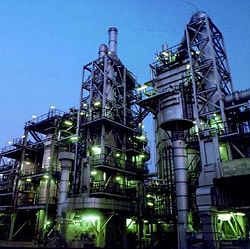User:Milton Beychok/Sandbox: Difference between revisions
imported>Milton Beychok No edit summary |
imported>Milton Beychok No edit summary |
||
| Line 1: | Line 1: | ||
'''Hydrocracking''' is a catalytic process used in [[petroleum refining processes|petroleum refineries]] for converting the [[Boiling point|high-boiling]] constituent [[hydrocarbon]]s in [[petroleum]] crude oils to more valuable lower-boilng products such as [[gasoline]], [[kerosene]], [[jet fuel]] and [[diesel oil]]. The process takes place in a [[Hydrogen|hydrogen-rich]] atmosphere at elevated [[temperature]]s (260 – 425 [[Celsius|°C]]) and [[pressure]]s (35 – 200 [[Bar (unit)|bar]]).<ref name=Gary>{{cite book|author=James H. Gary and Glenn E. Handwerk|title=Petroleum Refining: Technology and Economics|edition=2nd Edition|publisher=Marcel Dekker|year=1984|id=ISBN 0-8247-7150-8}}</ref><ref>{{cite journal| author=Editorial Staff|title=Refining Processes 2002|journal=Hydrocarbon Processing|volume= |issue=| pages=pages 115 – 117|date=November 2002|id=}}</ref><ref>{{cite journal|author= Naveen Bhutani, Ajay K. Ray and G.P. Rangaiah|title=Modeling, Simulation and Multi-objective Optimization of an Industrial Hydrocracking Unit|journal=Ind. Eng. Res.|volume=45|issue=4|pages=pages 1354 – 1372|date=2006|id= }}</ref> Basically, the process cracks the high-boiling, high [[molecular weight]] hydrocarbons into lower-boiling, lower molecular weight olefinic and aromatic hydrocarbons and then hydrogenates them. | {{Image|Hydrocracker 1.jpg|right|250px|A hydrocracking unit in a petroleum refinery.}} | ||
'''Hydrocracking''' is a catalytic process used in [[petroleum refining processes|petroleum refineries]] for converting the [[Boiling point|high-boiling]] constituent [[hydrocarbon]]s in [[petroleum]] crude oils to more valuable lower-boilng products such as [[gasoline]], [[kerosene]], [[jet fuel]] and [[diesel oil]]. The process takes place in a [[Hydrogen|hydrogen-rich]] atmosphere at elevated [[temperature]]s (260 – 425 [[Celsius|°C]]) and [[pressure]]s (35 – 200 [[Bar (unit)|bar]]).<ref name=Gary>{{cite book|author=James H. Gary and Glenn E. Handwerk|title=Petroleum Refining: Technology and Economics|edition=2nd Edition|publisher=Marcel Dekker|year=1984|id=ISBN 0-8247-7150-8}}</ref><ref>{{cite journal| author=Editorial Staff|title=Refining Processes 2002|journal=Hydrocarbon Processing|volume= |issue=| pages=pages 115 – 117|date=November 2002|id=}}</ref><ref>{{cite journal|author= Naveen Bhutani, Ajay K. Ray and G.P. Rangaiah|title=Modeling, Simulation and Multi-objective Optimization of an Industrial Hydrocracking Unit|journal=Ind. Eng. Res.|volume=45|issue=4|pages=pages 1354 – 1372|date=2006|id= }}</ref> | |||
Basically, the process cracks the high-boiling, high [[molecular weight]] hydrocarbons into lower-boiling, lower molecular weight olefinic and aromatic hydrocarbons and then hydrogenates them. Any [[sulfur]] and [[nitrogen]] present in the hydrocracking feedstock are, to a large extent, also hydrogenated and form gaseous hydrogen sulfide (H<sub>2</sub>S) and ammonia (NH<sub>3</sub>) which are subsequently removed. The result is that the hydrocracking products are essentially free of sulfur and nitrogen impurities. | |||
Hydrocracking plants are capable of processing a wide variety of feedstocks of different characteristics to produce a broad range of products. They can be designed and operated to maximize the production of a gasoline blending component (called ''hydrocrackate'') or to maximize the production of diesel oil. | |||
==History== | |||
Revision as of 16:10, 18 July 2009
Hydrocracking is a catalytic process used in petroleum refineries for converting the high-boiling constituent hydrocarbons in petroleum crude oils to more valuable lower-boilng products such as gasoline, kerosene, jet fuel and diesel oil. The process takes place in a hydrogen-rich atmosphere at elevated temperatures (260 – 425 °C) and pressures (35 – 200 bar).[1][2][3]
Basically, the process cracks the high-boiling, high molecular weight hydrocarbons into lower-boiling, lower molecular weight olefinic and aromatic hydrocarbons and then hydrogenates them. Any sulfur and nitrogen present in the hydrocracking feedstock are, to a large extent, also hydrogenated and form gaseous hydrogen sulfide (H2S) and ammonia (NH3) which are subsequently removed. The result is that the hydrocracking products are essentially free of sulfur and nitrogen impurities.
Hydrocracking plants are capable of processing a wide variety of feedstocks of different characteristics to produce a broad range of products. They can be designed and operated to maximize the production of a gasoline blending component (called hydrocrackate) or to maximize the production of diesel oil.
History
References
- ↑ James H. Gary and Glenn E. Handwerk (1984). Petroleum Refining: Technology and Economics, 2nd Edition. Marcel Dekker. ISBN 0-8247-7150-8.
- ↑ Editorial Staff (November 2002). "Refining Processes 2002". Hydrocarbon Processing : pages 115 – 117.
- ↑ Naveen Bhutani, Ajay K. Ray and G.P. Rangaiah (2006). "Modeling, Simulation and Multi-objective Optimization of an Industrial Hydrocracking Unit". Ind. Eng. Res. 45 (4): pages 1354 – 1372.
